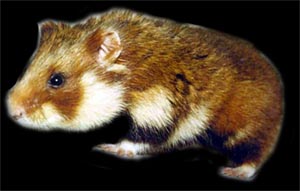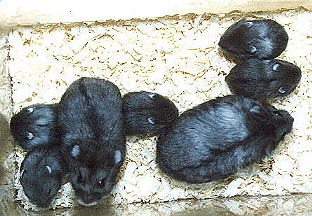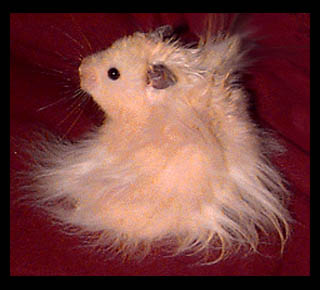Black Bear hamster
|

|
Aka "European black bear", "Californian Black Bear" - this is a marketing-joke to get a higher price for them. They are simple black shorthaired syrian golden hamsters. => syrian golden hamster
|
|
Californian Black Bear
|

|
=> syrian golden hamster
|
|
Cricetulus griseus
|

|
Scientific name for the chinese hamster
=> Chinese hamster
|
|
Cricetus cricetus
|

|
Scientific name for the european hamster.
=> European Hamster
|
|
Djungarian hamster
|

|
Another name for Winter white russian dwarf hamsters or siberian hamsters.
=> Russian dwarf hamster
|
|
Dri tail
|

|
This is an "over the counter"-antibiotic; available without prescription in the USA, Canada and Great Britain (fortunately not in Germany!). The manufacturer and a few people are telling stories about the ability of this product to cure Wet Tail (=> Health, Wet Tail).
Dri Tail is an unspecific antibiotic, that will never be able to cure a severe infection like Wet Tail! If your hamster is suffering an infection, veterinarian advice should be sought immediately. Hamsters are developing serious infections very fast, so that every day, if not every hour does count !
If Dri Tail did cure a problem, it was indeed not a severe infection. Most stories of successful from Wet Tail recovered hamsters by using Dri Tail are basically caused by wrong diagnosing of Wet Tail - they are simply misinterpreting a simple diarrhea as Wet Tail.
|
|
European Black Bear
|

|
=> syrian golden hamster
|
|
European Hamster
|

|
 Species Cricetus cricetus. Aka "European black bellied Hamster", "Fieldhamster". Please see the section Species/European Hamster for a closer description.
Species Cricetus cricetus. Aka "European black bellied Hamster", "Fieldhamster". Please see the section Species/European Hamster for a closer description.
The marketing-joke naming a black syrian hamster a "European [black] [bear] hamster" is already confusing many hamster-friends. The European Hamster is 27 to 32 cm long and not a common pet!
|
|
Fieldhamster
|

|
=> European Hamster
|
|
Hip spots
|

|
=> Scent glands (syrian hamster)
|
|
Mailing-List
|

|
 A mailing-list is basically a group of people with a common interest - eg. hamsters. After subscribing to a list, each subscriber of the list will get any mail any member of the list send to the list-server. So you can send questions or suggestions of a specific topic to many people only by sending one email to the list-server.
A mailing-list is basically a group of people with a common interest - eg. hamsters. After subscribing to a list, each subscriber of the list will get any mail any member of the list send to the list-server. So you can send questions or suggestions of a specific topic to many people only by sending one email to the list-server.
The banner on the right is the banner of the HamsterMailingList - the first choice for hamster-friends (IMO). Please see "Hamsters in CyberSpace"/"Mailing-Lists" for details.
(Picture courtesy of Susann Mireles)
|
|
Mesocricetus auratus
|

|
Scientific name for the syrian golden hamster.
=> Syrian golden hamster
|
|
Phodopus roborovskii
|

|
Scientific name for the roborovski hamster
=> Roborovski hamster
|
|
Phodopus campbelli
|

|
Scientific name for the campbell russian dwarf hamster.
Tne previously name "Phodopus sungoris campbelli" has been changed, cause campbells and
winter whites are not sub-species (same to Phodopus sungoris).
=> Russian dwarf hamster
|
|
Phodopus sungoris
|

|
Scientific name for the Winter white russian dwarf hamster, djungarian hamster or siberian hamster
Tne previously name "Phodopus sungoris sungoris" has been changed, cause campbells and
winter whites are not sub-species (same to Phodopus campbelli).
=> Russian dwarf hamster
|
|
Pinkies
|

|
Name for just born hamster-babies. Syrian hamsters are developing their fur at the age of 3 to 6 days; until then they are naked and their skin is pink.
|
|
RD
|

|
=> Russian dwarf hamster
|
|
Roboīs
|

|
=> Roborovsky hamster
|
|
Roborovsky Hamster
|

|
see species
|
|
Russian dwarf hamster
|

|
 Aka "RDīs" are "Campbell russian dwarf hamsters" or "Winter white russian dwarf hamsters"/"Djungarian/Siberian hamsters".
Aka "RDīs" are "Campbell russian dwarf hamsters" or "Winter white russian dwarf hamsters"/"Djungarian/Siberian hamsters".
The picture on the right (courtesy of Marianne Mays)
is showing a family of charcoal campbell russian dwarf hamsters. This is a new color first breed in Great Britain
and i am the proud cagecleaner of two pairs of them. I got them from Marianne Mays, a serious and experienced breeder
of hamsters (and other animals). Please see "Hamsters in CyberSpace"/"Private sites" for informations about Mariannes
homepage.
Although both are called russian dwarf hamsters, campbells and winter whites are separate species and not sub-species.
Thanks to Lorraine Hill for this informations.
See "Species"-section for details.
|
|
Scent glands
|

|
Syrian hamster:
Male and female syrian hamsters have a dark grey/black spot on each side on the hip. These are scent glands and nothing to worry about. Sometimes the hamster is losing his fur on top and around this spots. On males this spots are about 1 cm in diameter, on females this spots are smaller.
russian dwarf hamster:
The russian dwarf hamster (RD) has a scent gland just above the belly button with about 0.5 cm in diameter. This scent gland is equal to the hip spots on syrian hamsters.
Scent glands are producing an individual scent which the hamster is using to mark his territory.
|
|
Siberian hamster
|

|
Another name for Winter white russian dwarf hamsters or djungarian hamster.
=> Russian dwarf hamster
|
|
Syrian golden hamster
|

|
Species Mesocricetus auratus, aka "Fancy Hamster", "Common Hamster" or "golden Hamster".
This is the normal name for the syrian hamster or syrian golden hamster. Common coat-types are shorthaired and longhaired. The longhaired syrians are also known as "Teddy Hamster" or "Teddybear Hamster". Esp. in the USA, Canada and Great Britain some breeders and petshops are operating with the names "European Black Bear Hamster", "Californian Black Bear Hamster" or simple "Black Bear Hamster" - this is a marketing joke and rubbish. They are simple shorthaired black syrian hamsters. This isnīt a new species and this hamsters are very common in Europe, esp. in Germany.
|
|
Teddy hamster
|

|
 Aka "Teddy Bear Hamster" - Teddy hamsters are longhaired syrian golden hamsters. The only difference to "normal" syrian hamsters is the long fur. It is the same species. An example for the fur of a male longhaired hamsters is shown on the picture, the fur of female longhaired hamsters is not that long.
Aka "Teddy Bear Hamster" - Teddy hamsters are longhaired syrian golden hamsters. The only difference to "normal" syrian hamsters is the long fur. It is the same species. An example for the fur of a male longhaired hamsters is shown on the picture, the fur of female longhaired hamsters is not that long.
(Picture courtesy of Jill)
|
|












 Species Cricetus cricetus. Aka "European black bellied Hamster", "Fieldhamster". Please see the section Species/European Hamster for a closer description.
Species Cricetus cricetus. Aka "European black bellied Hamster", "Fieldhamster". Please see the section Species/European Hamster for a closer description.


 A mailing-list is basically a group of people with a common interest - eg. hamsters. After subscribing to a list, each subscriber of the list will get any mail any member of the list send to the list-server. So you can send questions or suggestions of a specific topic to many people only by sending one email to the list-server.
A mailing-list is basically a group of people with a common interest - eg. hamsters. After subscribing to a list, each subscriber of the list will get any mail any member of the list send to the list-server. So you can send questions or suggestions of a specific topic to many people only by sending one email to the list-server.








 Aka "RDīs" are "Campbell russian dwarf hamsters" or "Winter white russian dwarf hamsters"/"Djungarian/Siberian hamsters".
Aka "RDīs" are "Campbell russian dwarf hamsters" or "Winter white russian dwarf hamsters"/"Djungarian/Siberian hamsters".



 Aka "Teddy Bear Hamster" - Teddy hamsters are longhaired syrian golden hamsters. The only difference to "normal" syrian hamsters is the long fur. It is the same species. An example for the fur of a male longhaired hamsters is shown on the picture, the fur of female longhaired hamsters is not that long.
Aka "Teddy Bear Hamster" - Teddy hamsters are longhaired syrian golden hamsters. The only difference to "normal" syrian hamsters is the long fur. It is the same species. An example for the fur of a male longhaired hamsters is shown on the picture, the fur of female longhaired hamsters is not that long.

![]()